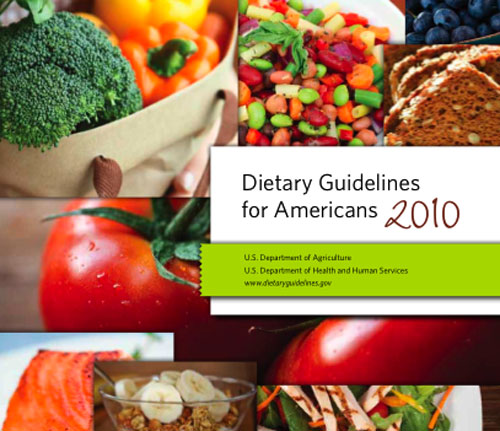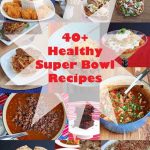I’ve been posting summaries of the 2010 Federal Dietary Guidelines for Americans that just got released last week. My last post summarized “Balancing Calories to Manage Weight.” Today, I will be summarizing the second recommendation, entitled “Foods and Food Components to Reduce.”
I found this chapter particularly challenging to summarize due to the amount of information covered (including lots of charts and graphs). I tried to organize the information in a more understandable format, by summarizing the recommendations, including the rationale behind “Why” the recommendation was made, and “How” each recommendation can be incorporated into your daily diet.
The general recommendations in this section are to reduce sodium, solid fat (saturated and trans fatty acids), added sugars and refined grains. The premise behind these recommendations is that by reducing these food items, not only will it be easier to control calorie intake to manage body weight, but the risk of certain chronic diseases will be reduced (e.g., cardiovascular disease, diabetes, and certain types of cancer).
HERE ARE SOME SPECIFIC RECOMMENDATIONS:
1. Reduce daily sodium intake to less than 2,300 mg (approximately 1 teaspoon)
applies to about half of the U.S. population, including children, and the
majority of adults.
Note: The estimated average intake of sodium for all Americans ages 2 years
an older is approximately 3,400 mg per day!
WHY?
• High sodium intake is associated with high blood pressure; keeping blood
pressure in the normal range reduces an individual’s risk of cardiovascular
disease, congestive heart failure and kidney disease.
HOW? (those highlighted in blue are my suggestions)
• Read Nutrition Facts labels for sodium content and purchase foods that are low in sodium
• Consume more fresh foods and fewer processed food that are high in
sodium.
• Eat more home-prepared foods, where you have more control over
sodium.
• Pay attention to portion size; although the sodium content of one serving
might not be that much, multiple servings add up, not just calorie wise,
but sodium wise, e.g., bread by itself is not high in sodium; however,
consumed in large quantities, the cumulative salt content adds up.
• Add salt just before serving; you’re likely to use less when you see how
much you’re adding.
2. Reduce consumption of solid fats (saturated fat and synthetic trans fatty
acids).
• Consume less than 10% of calories from saturated fatty acids by replacing
them with monounsaturated and polyunsaturated fatty acids.
• Consume less than 300 mg per day of dietary cholesterol.
• Keep trans fatty acid consumption as low as possible.
Note: The highest sources of saturated fat in the American diet for ages
2 years and older are: dairy (24.3%), red meat (13.4%), pizza (5.9%),
grain-based desserts (5.8%) {e.g., cakes, cookies, donuts}, and
chicken/chicken mixed dishes (5.5%)
WHY?
Saturated Fats:
• Consuming less than 10% of calories from saturated fatty acids and replacing
them with monounsaturated and/or polyunsaturated fatty acids is associated
with lower blood cholesterol levels, and therefore a lower risk of
cardiovascular disease.
Cholesterol:
• Moderate evidence shows a relationship between higher intake of
cholesterol and higher risk of cardiovascular disease.
• Consuming less than 300 mg per day of cholesterol can help attain normal
blood cholesterol levels; consuming less than 200 mg per day of cholesterol
can further help individuals at high risk of cardiovascular disease.
Trans Fatty Acids:
• Increased Trans Fatty Acid consumption has been associated with increased
risk of cardiovascular disease. According to the Guidelines, although
synthetic trans fatty acids are unsaturated fatty acids, “they are
structurally different from unsaturated fatty acids that occur naturally in
plant foods, and have dissimilar health effects.”
HOW? (those highlighted in blue are my recommendations)
To Reduce Saturated Fat and Cholesterol Intake:
• When preparing foods at home, replace solid fats (e.g., butter, lard) with
vegetable oils that are rich in monounsaturated and polyunsaturated fatty
acids (e.g.,olive oil, safflower oil).
• Purchase fat-free or low-fat milk.
• Trim fat from meat.
• Use less oil when cooking (e.g., try using 1 tablespoon olive oil when
sauteeing or stir-frying vegetables).
• Reduce the amount and portion sizes of dairy products, meat, pizza and
desserts you eat, e.g., treat desserts as just that…treats, not every night,
but once in a while, and in smaller portions; try Meatless Mondays.
• Buy lean cuts of meats.
To Reduce Synthetic Trans Fatty Acid Intake:
• Avoid products that include partially hydrogenated oils by reading food
ingredient labels (e.g. snack foods, prepared desserts, and some
margarines).
• Read labels on all prepared foods, especially baked goods; if partially
hydrogenated oils is listed, don’t buy it.
3. Limit the consumption of foods that contain refined grains, especially
refined grain foods that contain solid fats (saturated fatty acids and trans fats),
added sugars and sodium (e.g., store bought cookies, cakes, donuts). Also,
reduce the intake of calories from solid fats and added sugars.
Note:
• The major sources of refined grains in the American diet for ages 2 years and
older are: Yeast breads (25.9%), pizza (11.4%), grain-based desserts (9.9%)
{e.g., cakes, cookies, donuts}, tortillas, burritos, tacos (8.0%).
• Solid fats and added sugars contribute nearly 800 calories per day, without
contributing importantly to overall nutrient adequacy of the diet.
• The highest sources of added sugars in the American diet for ages 2 years and
older are: Drinks (46.2%) {e.g., soda, energy drinks, sports drinks, fruit
drinks}, and Desserts (19.4%) {grain-based desserts and dairy desserts}.
WHY?
• Although refined grains are often enriched with vitamins and minerals,
dietary fiber and some vitamins and minerals that are present in whole grains
are not routinely added back to refined grains.
• Added sugar and solid fat supply calories, but few or no essential nutrients
and no dietary fiber (added sugars and solid fats contribute an average of 35%
of the total calories in American diets).
HOW? (those highlighted in blue are my recommendations)
• Replace at least half of all grains eaten with whole grains.
• Reduce consumption of refined grain products that are also high in solid fats
and/or added sugars (e.g., cakes, cookies, donuts)
• Begin by substituting white breads with breads made with white whole wheat
flour, which is softer and whiter in color.
• When making rice, use half white rice, half brown rice to begin with; over
time, switch to 100% brown rice.
• Try whole grain pastas instead of white pasta (start with pastas that are
partially whole grain like Barilla, then gradually change to 100% whole grain).
• Treat cakes, cookies and donuts as special occasion treats, not everyday
foods.
4.If alcohol is consumed, consume in moderation.
WHY?
• Excessive drinking increases the risk of cirrhosis of the liver, hypertension,
stroke, type 2 diabetes, cancer of the upper gastrointestinal tract and colon,
injury and violence. Excessive drinking over time is associated with increased
body weight and can impair short-and long-term cognitive function.
HOW?
• Limit alcohol to up to one drink per day for women, and two drinks per day
for men (there are exceptions, including women who are pregnant or who
may be pregnant).
My takeaway from this section of the 2010 Federal Dietary Guidelines for Americans is this:
• The best and surest way to reduce consumption of sodium, solid fat, added
sugars and refined grains is to cook more food at home, where you have control
over what you put into your food. Seeing what goes into your food is the best
way to know what and how much you are consuming.
• However, since this may not be practical every day of the week, If you buy
prepared foods, carefully read food and ingredient labels before buying them
and check for saturated fat content, trans fatty acids (“partially hydrogenated
oils”), sodium content, added sugars, and refined grains (“enriched wheat
flour”).
• Pay attention to portion sizes; multiple portions add up.
• The bottom line is this: be a conscious, educated consumer; we are in charge of
our own bodies; take the time to either cook more at home and visually see
what you’re putting into your food, or carefully read food ingredient labels of
any processed foods you buy; taking care of your body now will pay off in the
long-run. It’s painless, there are plenty of delicious foods you can eat, and
you’ll thank yourself for taking charge of your own health.
There’s a lot of information in this post, but I feel that much of it is important to get the point across. I hope you find it useful. Let me know what you think of these recommendations, and if you have any practical ideas for reducing sodium, solid fats, added sugars and refined grains in the daily diet.











Uh oh, I think i'm probably way over the daily sodium guideline…
Most people are – the average person consumes 3,400mg/day. I am a big believer in reading labels, both the nutrition label and the ingredient label for any foods you don't buy fresh and prepare at home.
Jeanette, thanks for summarizing this important info for us! I try to live by the good stuff 😉